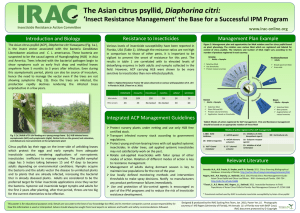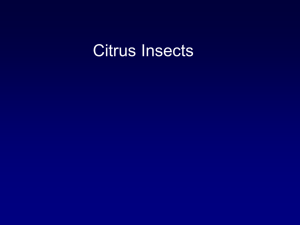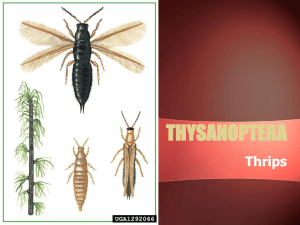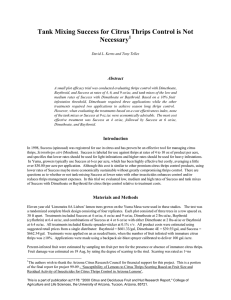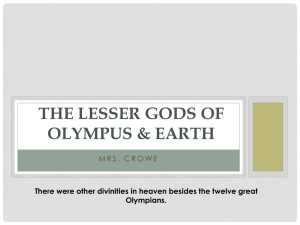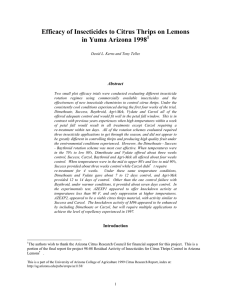Relative Susceptibility of Citrus Thrips Nymphs and Adults to Insecticides Abstract
advertisement
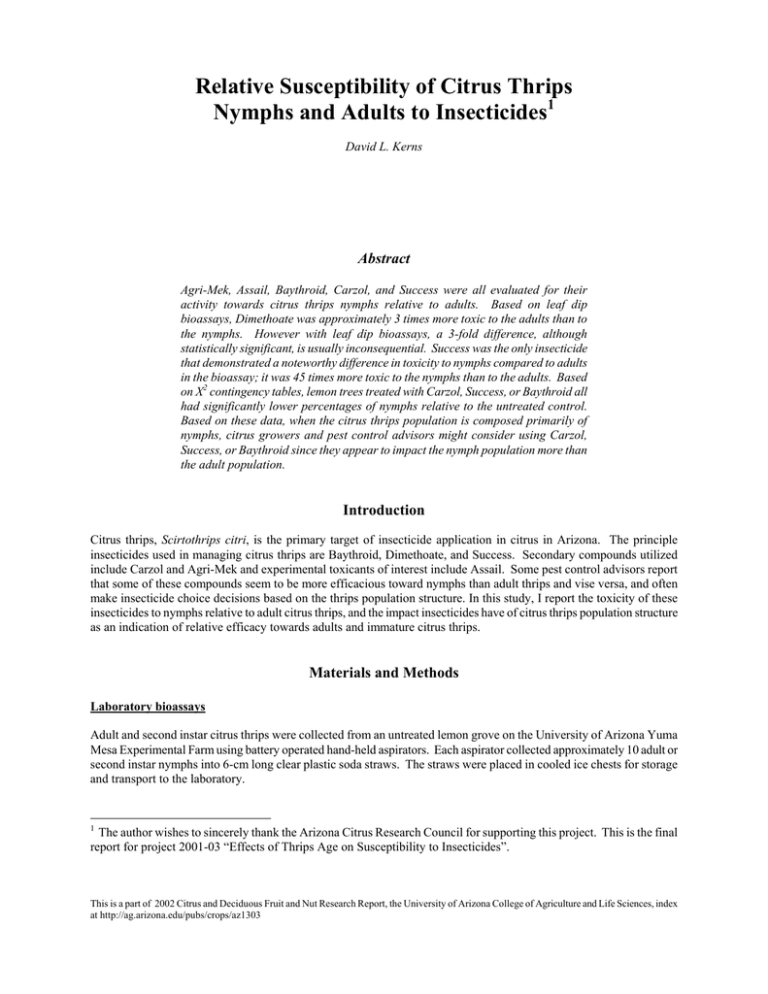
Relative Susceptibility of Citrus Thrips Nymphs and Adults to Insecticides1 David L. Kerns Abstract Agri-Mek, Assail, Baythroid, Carzol, and Success were all evaluated for their activity towards citrus thrips nymphs relative to adults. Based on leaf dip bioassays, Dimethoate was approximately 3 times more toxic to the adults than to the nymphs. However with leaf dip bioassays, a 3-fold difference, although statistically significant, is usually inconsequential. Success was the only insecticide that demonstrated a noteworthy difference in toxicity to nymphs compared to adults in the bioassay; it was 45 times more toxic to the nymphs than to the adults. Based on X2 contingency tables, lemon trees treated with Carzol, Success, or Baythroid all had significantly lower percentages of nymphs relative to the untreated control. Based on these data, when the citrus thrips population is composed primarily of nymphs, citrus growers and pest control advisors might consider using Carzol, Success, or Baythroid since they appear to impact the nymph population more than the adult population. Introduction Citrus thrips, Scirtothrips citri, is the primary target of insecticide application in citrus in Arizona. The principle insecticides used in managing citrus thrips are Baythroid, Dimethoate, and Success. Secondary compounds utilized include Carzol and Agri-Mek and experimental toxicants of interest include Assail. Some pest control advisors report that some of these compounds seem to be more efficacious toward nymphs than adult thrips and vise versa, and often make insecticide choice decisions based on the thrips population structure. In this study, I report the toxicity of these insecticides to nymphs relative to adult citrus thrips, and the impact insecticides have of citrus thrips population structure as an indication of relative efficacy towards adults and immature citrus thrips. Materials and Methods Laboratory bioassays Adult and second instar citrus thrips were collected from an untreated lemon grove on the University of Arizona Yuma Mesa Experimental Farm using battery operated hand-held aspirators. Each aspirator collected approximately 10 adult or second instar nymphs into 6-cm long clear plastic soda straws. The straws were placed in cooled ice chests for storage and transport to the laboratory. 1 The author wishes to sincerely thank the Arizona Citrus Research Council for supporting this project. This is the final report for project 2001-03 “Effects of Thrips Age on Susceptibility to Insecticides”. This is a part of 2002 Citrus and Deciduous Fruit and Nut Research Report, the University of Arizona College of Agriculture and Life Sciences, index at http://ag.arizona.edu/pubs/crops/az1303 New fully expanded leaves from ‘Limoneira 8A Lisbon’ lemon trees were collect into Zip-lock plastic bags and transported to the laboratory where they were rinsed with tap water to remove insects and dust. After the rinse water dried, the leaves were fully emerged into various concentrations of insecticides for 5 seconds, and placed under a fume hood, ventral side up, to dry. The insecticides tested included Agri-Mek, Assail, Baythroid, Carzol, Dimethoate, and Success. Baythroid and Carzol were tested at concentrations of 0, 1, 5, 10, 50, 100, and 500 ppm. Agri-Mek and Assail was tested at concentrations of 0, 1, 5, 10, 50, 100, 500, 1000 and 5000 ppm against the nymphs, and 0, 1, 5, 10, 50, 100, and 500 ppm against the adults. Dimethoate was tested at concentrations of 0, 1, 5, 10, 50, 100, 500, and 1000 ppm. Success was tested at concentrations of 0, 0.1, 0.5, 1, 5, 10 and 50 ppm against the nymphs, and 0, 1, 5, 10, 50, 100 and 500 ppm against the adults. All insecticide concentration contained Kinetic non-ionic surfactant at 0.1% v/v. The leaves were individually placed into Munger cells which exposed a 3.2-cm diameter circle of the center ventral portion of the leaf. Approximately 10 adult or second instar citrus thrips were placed into each cell. Four cells were utilized per treatment concentration. All tests were conducted at ambient laboratory conditions of 20 to 25ºC and 20 to 30% RH. The number of live and dead thrips was recorded after 24 hours. The data were analyzed with a Probit analysis corrected for control mortality using Abbott’s formula. Field Study In the field study, eight-year old ‘Limoneira 8A Lisbon’ lemon trees grown on the Yuma Mesa Experimental Farm were utilized. The test was a randomized complete block design consisting of four replicates. Each replicate contained three trees spaced 24 ft apart. The insecticide treatments included Agri-Mek at 8 oz/ac, Assail at 0.1 lbs-ai/ac, Baythroid at 6.4 oz/ac, Carzol at 1.0 lbs/ac, Dimethoate 4E at 2.0 lbs-ai/ac, and Success at 4 oz/ac. Assail and Baythroid were applied with Kinetic non-ionic surfactant at 0.1%v/v, Carzol and Dimethoate included Li-100 acidifying surfactant at 1.0% v/v, and Agri-Mek and Success included NR-415 spray oil at 1 gal/ac. The insecticides were applied with a customized orchard tower sprayer with a straight vertical boom containing seven D-2 nozzles spaced 20-in apart. The spray was calibrated to deliver 100 gal/ac at 80 psi. Treatments were applied on 25 May. Four days after treatment, flush growth was sampled using a beat-pan, where flush growth was gently tapped five times against hardware cloth covering a black cake pan with its bottom covered by a yellow stick card to trap the dislodged thrips. Four terminals were sampled per treatment replication. Each yellow sticky card was covered with clear cellophane plastic and transported to the laboratory where adult and immature citrus thrips were counted. The data were analyzed for differences in the frequency of adult and immature thrips within each insecticide treatment relative to an untreated control using multivariate X2 contingency tables. Results and Discussion Laboratory bioassays Dose mortality responses to second instar citrus thrips indicate that Success, Baythroid, Assail were the most toxic, followed by Carzol and lastly Dimethoate (Table 1). The dose mortality responses to adult thrips were similar in ranking (Table 2). These data do not reflect field efficacy since that are based on a linear response to a variety of dosages under laboratory conditions, whereas field efficacy is based on set rates influenced by a number of factors such coverage and environmental conditions. However, these data are valuable in that they can serve as a comparison point of relative toxicity of these insecticides for historical reference if control failures occur and resistance is suspected. When comparing the toxicity of each insecticide relative to adult and second instar citrus thrips, only Dimethoate and Success were statistically different. Dimethoate was approximately 3 times more toxic to the adults than to the nymphs (Figure 1). However, with leaf dip bioassays, a 3-fold difference, although statistically significant, is usually inconsequential. Success was the only insecticide that demonstrated a noteworthy difference in toxicity to nymphs compared to adults; it was 45 times more toxic to the nymphs than to the adults (Figure 1). Although this is not always evident in the field, it could explain why a Success application early in the season when flush growth is rapid and many adults are present is sometimes inconsistent. The fact that Success is more toxic to second instars is not surprising since most of Success’ activity comes after ingestion and second instar feed more than adult citrus thrips. Field Study To determine if differences in toxicity of insecticides to immature and adult citrus thrips could be observed under field conditions under normal insecticide use rates, frequency comparisons were evaluated 4 days after treatment of whole trees (Table 3). Based on X2 contingency tables, lemon trees treated with Carzol, Success, or Baythroid all significantly had a lower percentage of nymphs relative to the untreated control (Table 3). On the untreated trees nymphs constituted 82.87% of the thrips populations, where the Carzol, Success, and Baythroid treated trees had 55.10, 59.57, and 70.59% nymphs respectively. The apparent higher efficacy of nymphs relative to adults for Success can be explained by toxicological differences (Figure 1). However, the greater mortality of nymphs relative to adults on the Carzol and Baythroid treated trees is not clear. Based on these data, when the citrus thrips population is composed primarily of nymphs, citrus growers and pest control advisors might consider using Carzol, Success, and Baythroid since they appear to impact the nymph population more than the adult population. Table 1. Dose-mortality responses of second instar citrus thrips treated with insecticides by using a leaf dip bioassay. 95% fiducial limits Insecticide n Slope ± SE LC50 (ppm) Lower Upper df, X2 Agri-Mek 341 0.87 ± 0.10 7.45 4.20 12.01 6, 10.03 Assail 295 0.89 ± 0.12 6.46 2.96 11.34 6, 7.86 Baythroid 287 0.90 ± 0.13 3.24 1.64 5.30 4, 1.61 Carzol 217 1.58 ± 0.33 23.08 5.75 57.15 4, 11.86a Dimethoate 341 1.02± 0.26 262.99 179.05 414.57 6, 41.16a Success 306 0.94 ± 0.26 0.50 0.02 1.88 6, 27.94a a Chi-square significant (P < 0.05). Table 2. Dose-mortality responses of adult citrus thrips treated with insecticides by using a leaf dip bioassay. 95% fiducial limits Insecticide n Slope ± SE LC50 (ppm) Lower Upper df, X2 Agri-Mek 356 1.08 ± 0.11 8.46 5.65 12.20 4, 4.27 Assail 247 4.65 ± 0.30 7.50 3.10 16.21 4, 8.99 Baythroid 265 1.51 ± 0.51 2.00 0.001 8.27 4, 23.94a Carzol 303 1.25 ± 0.29 38.69 10.08 153.72 4, 18.45a Dimethoate 390 1.14 ± 0.25 86.39 61.98 123.09 4, 19.90a Success 247 1.65 ± 0.20 7.50 5.25 10.50 4, 13.82a a Chi-square significant (P < 0.05). 50 LC50 Adults / LC50 Nymphs 45 40 30 20 10 0.33 A ss ai l ho im et D Su cc es s e at zo l C ar id ro th Ba y A gr i-M ek 0 Figure 1. Ratio of the LC50 of adult to the LC50 of second instar citrus thrips. There was no significant difference in dose mortaltiy reponse of the nymphs vs adults where the 95% fiducial limits overlap. Where the 95% fiducial limits do not overlap, a value greater than one indicates that the nymphs are more susceptible, while a value less than one indicates that the adults are more susecptible. Table 3. Frequency of adults to nymphs of citrus thrips influenced by insecticides, 4 days after treatment. Treatment Adults Nymphs n X2, df, P Untreated vs. 17.13 82.87 181 Carzol 44.90 55.10 49 16.77, 1, 0.001 Dimethoate 21.43 78.57 112 0.840, 1, 0.360 Success 40.43 59.57 47 11.83, 1, 0.001 Agri-Mek 23.00 77.00 100 1.43, 1, 0.232 Assail 13.51 86.49 148 0.81, 1, 0.368 Baythroid 29.41 70.59 85 5.25, 1, 0.022 Analysis based on multivariant X2 contingency tables.

